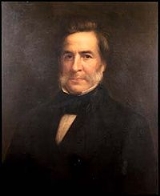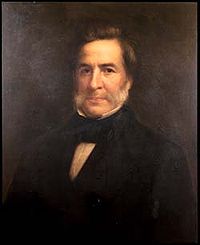
John Notman
Encyclopedia

Architect
An architect is a person trained in the planning, design and oversight of the construction of buildings. To practice architecture means to offer or render services in connection with the design and construction of a building, or group of buildings and the space within the site surrounding the...
, who settled in Philadelphia, Pennsylvania
Philadelphia, Pennsylvania
Philadelphia is the largest city in the Commonwealth of Pennsylvania and the county seat of Philadelphia County, with which it is coterminous. The city is located in the Northeastern United States along the Delaware and Schuylkill rivers. It is the fifth-most-populous city in the United States,...
. He is remembered for his churches, and for popularizing the Italianate style and the use of brownstone
Brownstone
Brownstone is a brown Triassic or Jurassic sandstone which was once a popular building material. The term is also used in the United States to refer to a terraced house clad in this material.-Types:-Apostle Island brownstone:...
.
Career
He was born in ScotlandScotland
Scotland is a country that is part of the United Kingdom. Occupying the northern third of the island of Great Britain, it shares a border with England to the south and is bounded by the North Sea to the east, the Atlantic Ocean to the north and west, and the North Channel and Irish Sea to the...
and educated at the Royal Scottish Academy
Royal Scottish Academy
The Royal Scottish Academy is a Scottish organisation that promotes contemporary Scottish art. Founded in 1826, as the Royal Institution for the Encouragement of the Fine Arts, the RSA maintains a unique position in Scotland as an independently funded institution led by eminent artists and...
. Notman worked in the office of William Henry Playfair
William Henry Playfair
William Henry Playfair FRSE was one of the greatest Scottish architects of the 19th century, designer of many of Edinburgh's neo-classical landmarks in the New Town....
in Edinburgh
Edinburgh
Edinburgh is the capital city of Scotland, the second largest city in Scotland, and the eighth most populous in the United Kingdom. The City of Edinburgh Council governs one of Scotland's 32 local government council areas. The council area includes urban Edinburgh and a rural area...
prior to emigrating to the United States
United States
The United States of America is a federal constitutional republic comprising fifty states and a federal district...
in 1831. He eventually settled in Philadelphia, Pennsylvania, where one of his first commissions was Laurel Hill Cemetery
Laurel Hill Cemetery
Laurel Hill Cemetery, in Philadelphia, Pennsylvania, is the second major garden or rural cemetery in the United States. It was designated a National Historic Landmark in 1998, one of only a few cemeteries to receive the distinction....
in 1835. He later opened and operated a successful firm until his death in 1865. Notman was also a founding member of the American Institute of Architects
American Institute of Architects
The American Institute of Architects is a professional organization for architects in the United States. Headquartered in Washington, D.C., the AIA offers education, government advocacy, community redevelopment, and public outreach to support the architecture profession and improve its public image...
and was committed to establishing professionalism in the practice of architecture in the United States.

Athenaeum of Philadelphia
The Athenaeum of Philadelphia, located in Philadelphia, Pennsylvania, is a special collections library founded in 1814 to collect materials "connected with the history and antiquities of America, and the useful arts, and generally to disseminate useful knowledge" for public benefit...
was the first Italianate building in his adopted city. Notman designed a number of suburban villas and country houses, including "Ogontz" (1863) for financier Jay Cooke
Jay Cooke
Jay Cooke was an American financier. Cooke and his firm Jay Cooke & Company were most notable for their role in financing the Union's war effort during the American Civil War...
.
Many of his designs for churches were dictated by the ideas of the Cambridge Camden Society
Cambridge Camden Society
The Cambridge Camden Society, later known as the Ecclesiological Society from 1845 when it moved to London, was a learned architectural society founded in 1839 by undergraduates at Cambridge University to promote "the study of Gothic Architecture, and of Ecclesiastical Antiques." Its activities...
who suggested that Anglican churches of the Low Church
Low church
Low church is a term of distinction in the Church of England or other Anglican churches initially designed to be pejorative. During the series of doctrinal and ecclesiastic challenges to the established church in the 16th and 17th centuries, commentators and others began to refer to those groups...
variety should be built in the Romanesque
Romanesque architecture
Romanesque architecture is an architectural style of Medieval Europe characterised by semi-circular arches. There is no consensus for the beginning date of the Romanesque architecture, with proposals ranging from the 6th to the 10th century. It developed in the 12th century into the Gothic style,...
style, while those of the High Church
High church
The term "High Church" refers to beliefs and practices of ecclesiology, liturgy and theology, generally with an emphasis on formality, and resistance to "modernization." Although used in connection with various Christian traditions, the term has traditionally been principally associated with the...
variety be built in the Gothic
Gothic architecture
Gothic architecture is a style of architecture that flourished during the high and late medieval period. It evolved from Romanesque architecture and was succeeded by Renaissance architecture....
style. He was also briefly employed by the Roman Catholic Diocese of Philadelphia during construction of the Cathedral of SS. Peter & Paul until an argument over the terms of his contract resulted in his dismissal.
Notman was also the architect of the highly influential New Jersey State Lunatic Asylum in Trenton New Jersey of 1847. This building was the first example of the Kirkbride Plan
Kirkbride Plan
The Kirkbride Plan refers to a system of mental asylum design advocated by Philadelphia psychiatrist Thomas Story Kirkbride in the mid-19th century.-History:The establishment of state mental hospitals in the U.S...
in asylum design.
Following Notman's death, the firm continued for a couple years under his protogee George Hewitt.
Churches
,_1625_locust_street,_philadelphia_(philadelphia_county,_pennsylvania).jpg)
- Chapel of the Holy Innocents, Saint Mary's Hall, Burlington, NJ (1845).
- St. Thomas Episcopal Church, Glassboro, NJ (1846).
- St. Paul's Episcopal Church, Trenton, NJ (1848). Attributed to Notman.
- St. Mark's ChurchSt. Mark's Episcopal Church, PhiladelphiaSt Mark's Episcopal Church, Philadelphia, at 1625 Locust St, Center City, Philadelphia, Pennsylvania, is an Episcopal church in the Anglo-Catholic tradition. It is part of the Diocese of Pennsylvania.-History:...
, 1625 Locust Street, Philadelphia, PA (1849). Tower completed by George Hewitt (1865). Lady Chapel by Cope & StewardsonCope & StewardsonCope & Stewardson was an architecture firm best known for its academic building and campus designs. The firm is often regarded as a Master of the Collegiate Gothic style. Walter Cope and John Stewardson established the firm in 1885, and were later joined by Emlyn Stewardson in 1887...
(1899-1902). - Emmanuel ChurchEmmanuel Episcopal Church (Cumberland)thumb|rightThe Emmanuel Episcopal Church of Cumberland, Maryland located in Cumberland's Historic District, is built on the foundations of Fort Cumberland, where George Washington began his military career; earthworks from the fort still lie beneath the church...
, Cumberland, MD (1851). - St. Peter's Church, Pittsburgh, PA (1851).
- St. Clement's Church, Philadelphia, PA (1855-59).
- Church of the Holy TrinityChurch of the Holy Trinity, PhiladelphiaChurch of the Holy Trinity is an Episcopal church on Rittenhouse Square in Philadelphia, Pennsylvania. The first service in the church building, designed by Scottish architect John Notman, was held on March 27, 1859. The corner tower was added in 1867 and was designed by George W...
, Rittenhouse Square, Philadelphia, PA (1856-59). - Cathedral Church of St. John the EvangelistEpiscopal Diocese of DelawareThe Episcopal Diocese of Delaware is one of 108 dioceses making up the Episcopal Church in the United States of America. It consists of 38 congregations or Parishes in an area the same as the State of Delaware...
, Concord Ave. & Market St., Wilmington, DE (1858).
Further reading
- Constance M. Greiff, John Notman Architect, 1810-1865. Philadelphia: Athenaeum of Philadelphia, 1979.
- Carla Yanni, The Architecture of Madness: Insane Asylums in the United States, University of Minnesota Press, 2007.

